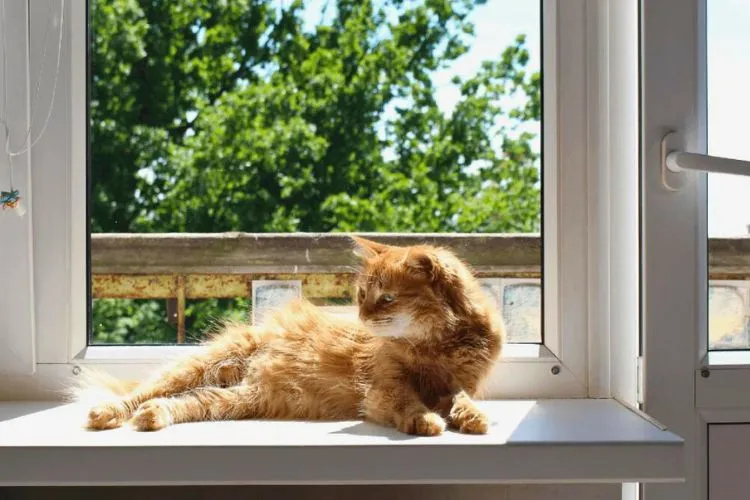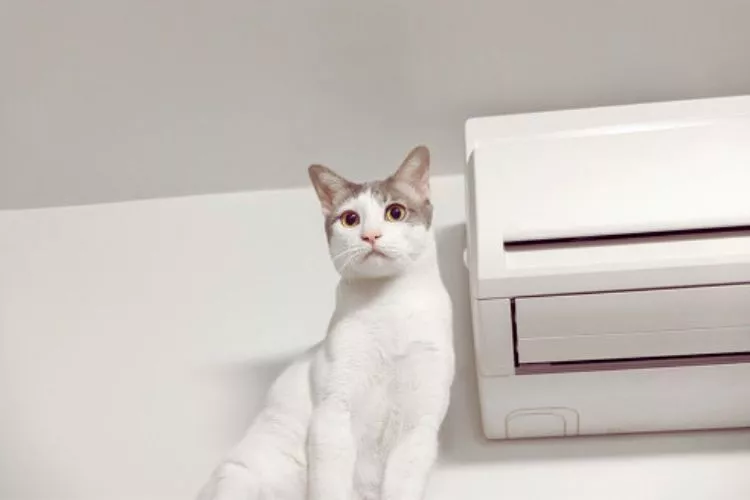Cats, known for their independent attitudes and resilience, are also creatures that adapt well to various climates.
However, when it comes to their comfort and well-being, temperature plays a vital role. As a cat owner, being educated on what temperatures are safe for your feline companion can be paramount.
It is incumbent upon us to answer a question that might be on the mind of many cat owners – is 90 degrees too hot for a cat?
This article will delve into the specific temperature range cats can safely tolerate, the potential risks associated with heat, and how to ensure your cat’s safety during hot weather.

🐾 Is 90 degrees too hot for a cat?
Yes, 90 degrees is generally considered too hot for a cat. Cats are most comfortable and thrive in temperatures 70 to 80 degrees Fahrenheit.
While they can tolerate higher temperatures, prolonged exposure to temperatures around 90 degrees or higher can lead to heat stress, dehydration, and in severe cases, heatstroke.
Pet owners need to monitor their cat’s behavior, provide ample access to fresh water, shade, and cooler areas within the household, and avoid excessive activity during hot weather.
Cat owners can ensure their feline friends remain healthy and comfortable even in warmer conditions by taking the necessary precautions and keeping a diligent eye on the temperature.
🐾 What temperature can a cat tolerate?
Cats can generally tolerate different temperature ranges. However, the optimal temperature for long-haired and short-haired cat breeds is between 75°F and 80°F.
It’s particularly important to monitor temperatures carefully as cats can have difficulty once the temperature rises above 80°F, and these levels can lead to complications such as heat exhaustion, heatstroke, and even sunburn.
Conversely, cats can also suffer in excessively cold conditions; for instance, a temperature below 32 degrees Fahrenheit can lead to hypothermia.
Therefore, while cats have a degree of resilience to temperature variations, ensuring their environment stays within safe temperature boundaries is crucial.
🐾 What temperature is too hot for cats indoors?
Although cats are adaptable creatures, a temperature above 80°F can become uncomfortable indoors. Remember that temperatures that feel comfortable to humans may not feel the same to your cat.

Extended exposure to temperatures above this threshold, particularly if the environment lacks proper ventilation, can potentially lead to heat stress or heatstroke.
It’s crucial to provide your cat with cooler areas in the house and fresh water and monitor their behavior in hot weather.
🐾 What temperature can cats tolerate outside?
Cats generally prefer the same comfortable temperature range as humans, roughly between 70°F and 80°F, even when they are outside. When temperatures rise above 80°F, cats can face the risk of dehydration, heat exhaustion, or other heat-related health problems.
In colder weather, if it’s below 45 degrees, most cats seek shelter to keep warm and prevent hypothermia. Always observe your cat’s behavior in changing climates for any signs of stress or discomfort.
🐾 Can cats survive without AC?
Yes, cats can survive without air conditioning. It is, however, important to maintain a comfortable climate inside the home. If you are okay with the temperature levels, your pets will most likely feel the same.

However, it does not mean that they will always be comfortable. Cats are very sensitive to heat and can suffer heat stroke if they get too hot.
Therefore, while cats can survive without air conditioning, it’s crucial to ensure they remain cool and comfortable, particularly during the warm months.
🐾 How do I keep my cat cool when my AC breaks?
If your AC breaks, there are several ways you can help keep your cat cool and comfortable:
- Ventilation: Ensure adequate airflow by opening windows or using fans to circulate the air.
- Shade: Close curtains or blinds to prevent direct sunlight from entering the room.
- Fresh Water: Provide your cat with fresh water to prevent dehydration. You can also add ice cubes to keep the water cooler.
- Cool Surfaces: Cats prefer lying on cool surfaces like tile floors, so provide access to such areas in the house.
- Frozen Treats: Offer them ice cubes or homemade frozen cat-friendly treats.
- Grooming: Regularly groom your cat to remove excess fur, particularly for long-haired breeds.
- Cooling Pads: Provide a cooling pad or damp towel for your cat to lie on.
Always monitor your cat’s behavior for any signs of distress or overheating, and consult a veterinarian if you’re concerned about your cat’s health during a heatwave.
🐾 frequently asked question (FAQs)
No, 80 degrees Fahrenheit is not too hot for cats. They are fairly adaptable and can tolerate temperatures up to 86 degrees Fahrenheit[^5^]. But providing plenty of fresh water and shade is crucial if your cat seems uncomfortable.
An indoor temperature of 85 degrees Fahrenheit is generally safe for cats. They deal better with heat than humans physiologically, but if they seem uncomfortable, it’s important to provide fresh water, shade, or a cooler area.
Cats can tolerate temperatures up to about 30 degrees Celsius. Above this, ensure your cat can access cool, shaded areas and fresh drinking water to prevent heat stress or heatstroke.
The safe indoor temperature for cats is between 70 and 80 degrees Fahrenheit. Cats are fairly adaptable, but temperatures above 86 degrees Fahrenheit can cause discomfort and risk of heat stress or heatstroke if exposed longer.
Conclusion :
While cats have a higher threshold for heat than humans, a persistent indoor temperature of 90 degrees Fahrenheit can be uncomfortable and potentially harmful.
Cats can generally tolerate temperatures up to about 86 degrees Fahrenheit, but prolonged exposure to heat can lead to issues like heat stress or heat stroke.
Providing plenty of fresh water, shade, and cool spots for cats to retreat is essential in maintaining their comfort and well-being during hot weather.
Monitoring your cat’s behavior during high temperatures is also essential to ensure they are not showing signs of heat-related distress.
Thus, while cats can cope better than humans in hot weather, caution and care should still be extended when temperatures hit 90 degrees.
